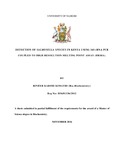| dc.description.abstract | Salmonella species have been identified worldwide as a common cause of bacteremia among the
immunocompromised individuals and infants where in severe cases it has proved fatal. Although various tests including culture and serological methods have been traditionally used for Salmonella spp. detection they have been reported to be less sensitive and time consuming. In Kenya, the serological based widal test is the most widely used assay for Salmonella detection. Although the assay is rapid, its utility has been limited by its low sensitivity. A more specific DNA based assays, though quite promising in speed, specificity and sensitivity, have also not been able to distinguish among different Salmonella species. Thus, a more rapid and specific assay is required for Salmonella identification. High-resolution melting point assay (HRMA) is a new, rapid nucleic based diagnostic test that has been recently developed to detect specific DNA sequence variations and has thus been applied in the specific identification and differentiation of many closely related bacterial species such as Salmonella. This study was hence aimed at developing and evaluating HRMA as a rapid, precise and more sensitive technique for the identification of Salmonella serovars circulating among domestic animals in Kenya.
Fecal materials of pigs and cattle and cloacal swabs from poultry as well as the egg contents were each used for the isolation of Salmonella serovars by first being grown in enrichment media and subsequently isolated on XLD a selective media. The isolated Salmonella species were further characterized biochemically using API 20E strips based on the different colour changes upon specific substrate utilization. To identify specific serovars in the samples, DNA was then extracted from the identified Salmonella spp. and then subsequently subjected to HRMA assay using the V1, V3 and V6 primers specific for the 16S rRNA region. The control DNA sample was serially diluted tenfold and used to evaluate the limit of detection of the HRMA. The HRMA
xi
specificity was also evaluated by subjecting an artificially prepared poly microbial sample consisting S. Enteritidis, S. Gallinarum, S. Typhi, and S. Braenderup DNA as the positive controls.
The results indicated that the egg and pig fecal materials had the highest prevalence of Salmonella at 9.21% and 8.24 % respectively. On the other hand chicken and cattle samples had the least prevalence at 4.1% and 4% respectively as determined by the culture method. However, there was a sizeable decline in the prevalence of Salmonella in the sample when biochemically characterized by API 20E strips. Using this method, only 5.99% of the egg samples were contaminated with Salmonella, 3.85% were positive in the pig’s fecal material, 3.66% in chicken swabs while, 2.67% of the sampled cows fecal materials were contaminated with Salmonella. This clearly indicates that biochemical detection of Salmonella by API 20E strips was more sensitive than culture method. HRM assay generated unique melt profiles for each Salmonella serovar controls including S. Typhi, S. Typhimurium, S. Enteritidis, S. Gallinarum, S. Braenderup, S. Dublin, and S. Choleraesuis. Based on this assay the main circulating serovars identified in Nairobi and the surrounding environment were S. Typhimurium, S. Enteritidis, S. Braenderup, and S. Choleraesuis. The limit of detection of Salmonella DNA in the samples was as low 0.031ng/μl indicating that not only was the technique specific but it’s also more sensitive.
In conclusion the HRM assay developed in this study is rapid, sensitive and specific but is also capable of differentiating among different Salmonella serovars. This assay is a valuable and promising diagnostic tool, which could enhance the early detection, identification and prevalence determination for an effective control strategy of Salmonella species. This could be important in reducing misdiagnosis of Salmonella, which has currently led to misuse of antibiotics hence the emergence of Salmonella resistant serovars. | en_US |



